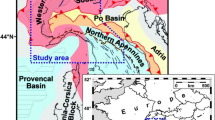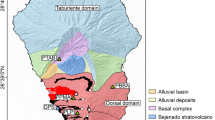Abstract
The new permanent seismic station SVZ started working in Arctic (Severnaya Zemlya archipelago, Bolshevik Island), we discuss the first results of the local seismicity study. We have processed 46 local seismic events for 2017–2022. Data processing using a single seismic sensor is difficult, but using waveforms and spectral-temporal analysis of P, S, and surface waves, it is possible to separate shallow earthquakes from glacial events. We distinguish two types of icequakes—glacier-related events and pulses. An increase in seismic background noise is related to processes of glacial nature in summertime. Data processing allows to obtain the main peculiarities of local seismicity, i.e., mutual connection of glacial processes and crustal seismicity. We show the presence of icequakes induced by local crustal events; their epicenters confined to the ice domes edges. Spatio-temporal sequence and the rate of events migration show that the glacial events are a result of the defusing deformations process in the glaciers caused by the impact of shallow tectonic earthquakes. Thousands of pulsed and high-frequency micro-oscillations associate with the sea ice sheet or lake ice. The temporal variation of events’ number and energy per day correlates with air temperature temporal variations. Moreover, there is a sharp increase in the number of pulses with sharp temperature changes. The greatest activity of this pulsed events is in winter and especially in March, connected with ice surface destruction. In case a network deployment is not feasible, even a single seismic station allows to get a useful information about the glacial and seismic processes.












Similar content being viewed by others
Data availability
Absolute marks of glaciers of the Severnaya Zemlya archipelago can be accessed from a map form the next website: https://geographyofrussia.com/karta-severnaya-zemlya. Catalogs of N. Laverov Federal Center for Integrated Arctic Research of the Ural Branch of the Russian Academy of Sciences (FECIAR UrB RAS) are available upon official request, http://fciarctic.ru/ing.php?page=contact.
References
Akimov AP, Krasilov SA (2020) Program Complex WGS "System of Processing of Seismic Data". Certificate of State Registration of Computer Programs № 2020664678 of November 16, 2020. Rospatent
Antonovskaya GN, Kovalev SM, Konechnaya YAV, Smirnov VN, Danilov AV (2018) New information on the seismicity of the Russian Arctic according to the Severnaya Zemlya seismic observation point. Arctic and Antarctic Research 64(2):170–181. https://doi.org/10.30758/0555-2648-2018-64-2-170-181
Atlas “Geology and mineral resources of the Russian shelf areas” (2004) Editor-in-chief Alekseev M.N. Moscow
Atlas of the Abrasive and Ice-exaration hazard of the coastal-shelf zone of the Russian Arctic (2020) Compilers: S.A. Ogorodov et al. Russia: Lomonosov Moscow State University, Moscow
Berg B, Bassis J (2022) Crevasse advection increases glacier calving. J of Glaciol 1–10. https://doi.org/10.1017/jog.2022.10
Blankenship DD, Anandakrishnan S, Kempf JL, Bentley CR (1987) Microearthquakes under and alongside ice stream B, Antarctica. Detected by a new passive seismic array. Annals of Glaciol 9:30–34. https://doi.org/10.3189/S0260305500200712
Bogorodskii PV, Makshtas AP, Kustov VYu, Movchan VV (2018) The dynamics of seasonal thawing of permafrost in the region of research station “Ice base Cape Baranov” (Bolshevik island, Severnaya Zemlya archipelago) Problemy Arktiki i Antarktiki. Arctic and Antarctic Research. 64(1):16–30. [In Russian]. https://doi.org/10.30758/0555-2648-2018-64-1-16-30
Borodkin VA, Kovalev SM, Shushlebin AI (2019) Change of structure and some physical properties of level fast ice during the spring and summer period of 2014 in the vicinity the research station “Ice base Cape Baranov.” Arc Antarct Res 65(1):63–76. https://doi.org/10.30758/0555-2648-2019-65-1-63-76
Chmiel M, Walter F, Preiswerk L, Funk M, Meier L, Brenguier F (2021) Hanging glacier monitoring with icequake repeaters and seismic coda wave interferometry: a case study of the Eiger hanging glacier. Nat. Hazards Earth Syst Sci Discuss [preprint]. 10.5194/nhess-2021-205
Deichmann N, Ansorge J, Scherbaum F, Aschwanden A, Bernardi F, Gudmundsson GH (2000) Evidence for deep icequakes in an Alpine glacier. Annals of Glaciol 31(1):85–90. https://doi.org/10.3189/172756400781820462
ELRESS, Event Locator Seismological Software (2021) http://www.krsc.ru/?q=en/EL. Accessed May 5, 2023
FECIAR UrB RAS, Arkhangelsk seismic network (ASN). http://fciarctic.ru/index.php?page=geoss. Accessed May 5, 2023
Fedorov AV, Asming VE (2015) Monitoring of Spitsbergen glacier activity by the seismic method. Nauka i tehnologicheskie razrabotki 94(4):44–52. https://elibrary.ru/download/elibrary_26165154_79157235.pdf
Guillemot A, Helmstetter A, Larose É, Baillet L, Garambois S, Mayoraz R, Delaloye R (2020) Seismic monitoring in the Gugla rock glacier (Switzerland): ambient noise correlation, microseismicity and modelling. Geophys J Int 221(3):1719–1735. https://doi.org/10.1093/gji/ggaa097
Helmstetter A, Nicolas B, Comon P, Gay M (2015) Basal icequakes recorded beneath an Alpine glacier (Glacier d’Argentière, Mont Blanc, France): evidence for stick-slip motion? J Geophys Res Earth Surf 120:379–401. https://doi.org/10.1002/2014JF003288
Hudson TS, Brisbourne AM, Walter F, Gräff D, White RS, Smith AM (2020) Icequake source mechanisms for studying glacial sliding. J Geophys Res: Earth Surf 125(11). https://doi.org/10.1029/2020JF005627
Jepsen DC, Kennett BLN (1990) Three-component analysis of regional seismograms. Bull Seism Soc America 80(6B):2032–2052. https://doi.org/10.1785/BSSA08006B2032
Johannessen OM, Bobylev LP, Shalina EV, Sandven S (2020) Sea ice in the Arctic: past, present and future. Springer 579 ISBN: 978–3–030–21301–5
Jurkevics A (1988) Polarization analysis of three-component array data. Bull Seism Soc America 78:1725–1743. https://doi.org/10.1785/BSSA0780051725
Kapustian NK, Shakhova EV, Antonovskaya GN (2022) New opportunities for epicentral seismic observations. Seism Instr 58:732–742. https://doi.org/10.3103/S0747923922060068
Kawasaki I, Asai Y, Tamura Y (2001) Space-time distribution of interpolate moment release including slow earthquakes and the seismo-geodetic coupling in the Sanriku-oki region along the Japan trench. Tectonophysics 330:267–283. https://doi.org/10.1016/S0040-1951(00)00245-6
Kocharyan GG (2016) Fault geomechanics, Moscow, pp 337–344 (in Russian).
Köhler A, Maupin V, Nuth C, Van Pelt W (2019) Characterization of seasonal glacial seismicity from a single-station on-ice record at Holtedahlfonna Svalbard. Ann Glac 60(79):23. https://doi.org/10.1017/aog.2019.15
Köhler A, Nuth C, Schweitzer J, Weidle C, Gibbons SJ (2015) Regional passive seismic monitoring reveals dynamic glacier activity on Spitsbergen, Svalbard. Polar Res 34. https://doi.org/10.3402/polar.v34.26178
Kotlyakov VM (2019) Glaciers. Great Russian Encyclopedia. https://bigenc.ru/geology/text/5556912? Accessed May 5, 2023)
Kremenetskaya E, Asming V, Ringdal F (2001) Seismic location calibration of the European Arctic. Pure and Appl Geophys 158:117–128. https://doi.org/10.1007/PL00001151
Lay T, Wallace TC (1995) Modern global seismology. CA, Academic Press, San Diego
Malyshev NA, Nikishin VA, Obmetko VV, Kleshchina LN, Reydik YuV, Nikishin AM, Martirosyan VN (2012) A new model of the geological structure and evolution of the North Kara Sedimentary Basin. Dokl Earth Sci 445(1):791–795. https://doi.org/10.1134/S1028334X12070057
Mikesell TD, K van Wijk, Haney MM, Bradford JH, Marshall HP, Harper JT (2012) Monitoring glacier surface seismicity in time and space using Rayleigh waves. J Geophys Res 117(F2). https://doi.org/10.1029/2011JF002259
Morozov AN, Vaganova NV, Asming VE, Evtyugina ZA (2020) The ML scale in Western Eurasian Arctic. Russian J Seism 2(4):63–68. https://doi.org/10.35540/2686-7907.2020.4.06
Morozov AN, Vaganova NV, YaV K, Asming VE, Dulentsova LG, Evtyugina ZA (2021) Seismicity in the far Arctic areas: Severnaya Zemlya and the Taimyr Peninsula. J Seism 25(5):1171–1188. https://doi.org/10.1007/s10950-021-10032-1
O’Neel S, Marshall HP, McNamara DE, Pfeffer WT (2007) Seismic detection and analysis of icequakes at Columbia Glacier Alaska. J Geophys Res 112:F03S23. https://doi.org/10.1029/2006JF000595
O’Neel S, Pfeffer WT (2007) Source mechanics for monochromatic icequakes produced duringiceberg calving at Columbia Glacier, AK. Geoph Res Let 34(22). https://doi.org/10.1029/2007GL031370
Ohta Y, Freymueller JT, Hreinsdóttir S, Suito HA (2006) A large slow slip event and the depth of the seismogenic zone in the south central Alaska subduction zone. Earth and Plan Science Let 247(1–2):108–116. https://doi.org/10.1016/j.epsl.2006.05.013
Podolskiy EA, Walter F (2016) Cryoseismology Review Geoph 54:708–758. https://doi.org/10.1002/2016RG000526
Pubellier M, Rossi P, Petrov O, Shokalsky S, St-Onge M, Khanchuk A, Pospelov I (2018) Tectonic map of the Arctic. 1st ed., scale 1:10 000 000. VSEGEI Printing House. St. Petersburg, Russia. https://doi.org/10.14683/2018TEMAR10M
Sánchez-Gámez P, Navarro FJ, Dowdeswell JA, De Andrés E (2020) Surface velocities and calving flux of the Academy of Sciences Ice Cap Severnaya Zemlya. Ice and Snow 60(1):19–28. https://doi.org/10.31857/S2076673420010020
Shaposhnikov VM, Aleksandrov AV, Matantsev RA, Inavovskaya OD (2017) Iceberg risk analysis for the Northern Sea route: LNG carrier study case. Arctic: Ecol Econ 2(26):76–81. https://doi.org/10.25283/2223-4594-2017-2-76-81
Spencer AM, Embry AF, Gautier DL, Stupakova AV, Sørensen K (2011) Arctic Petroleum Geology. Geological Society Memoir. London: Geological Society 35. https://doi.org/10.1144/M35.21
Stuart G, Murray T, Brisbourne A, Styles P, Toon S (2005) Seismic emissions from a surging glacier: Bakaninbreen, Svalbard. Annals of Glaciol 42:151–157. https://doi.org/10.3189/172756405781812538
Turova AP, Morozova ER (2019) The contribution of the seismic station “Severnaya Zemlya” to the study of arctic seismicity. Arctic Environmental Res 19(4):139–145. https://doi.org/10.3897/issn2541-8416.2019.19.4.139
USSR Glacier Catalog (1980) Editor-in-Chief Vinogradov ON. 16(1). Leningrad, Gidrometeoizdat [in Russian]
Vinogradov YA, Fedorov AV, Baranov SV, Asming VE, Fedorov IS (2021) Identification of iceberg-forming ice quakes from seismic and infrasound data. Ice and Snow 61(2):262–270. https://doi.org/10.31857/S2076673421020087
Wathelet M, Chatelain J-L, Cornou C, Di Giulio G, Guillier B, Ohrnberger M, Savvaidis A (2020) Geopsy: a user-friendly open-source tool set for ambient vibration processing. Seismol Res Lett 91(3):1878–1889. https://doi.org/10.1785/0220190360
West ME, Larsen CF, Truffer M, O’Neel S, Le Blanc L (2010) Glacier microseismicity. Geology 38(4):319–322. https://doi.org/10.1130/G30606.1
Acknowledgements
We thank Sergey Kovalev, Head of the Ice Physics Laboratory of the Arctic and Antarctic Research Institute, for his help in organizing the seismic station installation on the Severnaya Zemlya archipelago and its maintenance. We are thankful to VSEGEI personnel for kindly letting us make use of the Arctic tectonic map in digital format. Special thanks go to Vladimir Asming for creating Event Locator program.
Funding
This study was funded by Russian Federation Ministry of Science and Higher Education according to the research project 122011300389–8 and the state task of the IPE RAS.
Author information
Authors and Affiliations
Contributions
Data processing: all authors. Methodology: Natalia Kapustian and Yana Konechnaya. Visualization: Galina Antonovskaya, Yana Konechnaya, and Ekaterina Morozova. Writing—original draft preparation: Galina Antonovskaya, Natalia Kapustian, and Yana Konechnaya. Writing—review and editing: Galina Antonovskaya and Natalia Kapustian. Funding acquisition: Galina Antonovskaya.
Corresponding author
Ethics declarations
Competing interests
The authors declare no competing interests.
Additional information
Publisher's Note
Springer Nature remains neutral with regard to jurisdictional claims in published maps and institutional affiliations.
Highlights
• Using a single permanent seismic station in the Severnaya Zemlya archipelago allows to make progress in the investigation of this poorly studied Arctic territory, in particular to get new information about the glacial and seismic processes.
• Between 2017 and 2022, we detected 46 seismic events with local magnitude from 0.2 to 4.9, 35 for October Revolution Island and 11 for Bolshevik Island. The seismic station temporarily did not work in 2019 and 2021. Using spectral and polarization analysis, we were able to divide these events into two groups as shallow earthquakes and glacier events. Also, we show that October Revolution Island earthquakes induced icequakes in ice domes.
• We recorded the thousands of visible pulses greater than noise. Their number correlates to the air temperature sharp change and occurs most often in wintertime. The nature of such events is related to sea or lake ice sheet cracking.
Rights and permissions
Springer Nature or its licensor (e.g. a society or other partner) holds exclusive rights to this article under a publishing agreement with the author(s) or other rightsholder(s); author self-archiving of the accepted manuscript version of this article is solely governed by the terms of such publishing agreement and applicable law.
About this article
Cite this article
Antonovskaya, G.N., Kapustian, N.K., Konechnaya, Y.V. et al. Glacial and seismic events investigation from a single-station record at Severnaya Zemlya archipelago (Arctic region). J Seismol (2024). https://doi.org/10.1007/s10950-024-10208-5
Received:
Accepted:
Published:
DOI: https://doi.org/10.1007/s10950-024-10208-5




